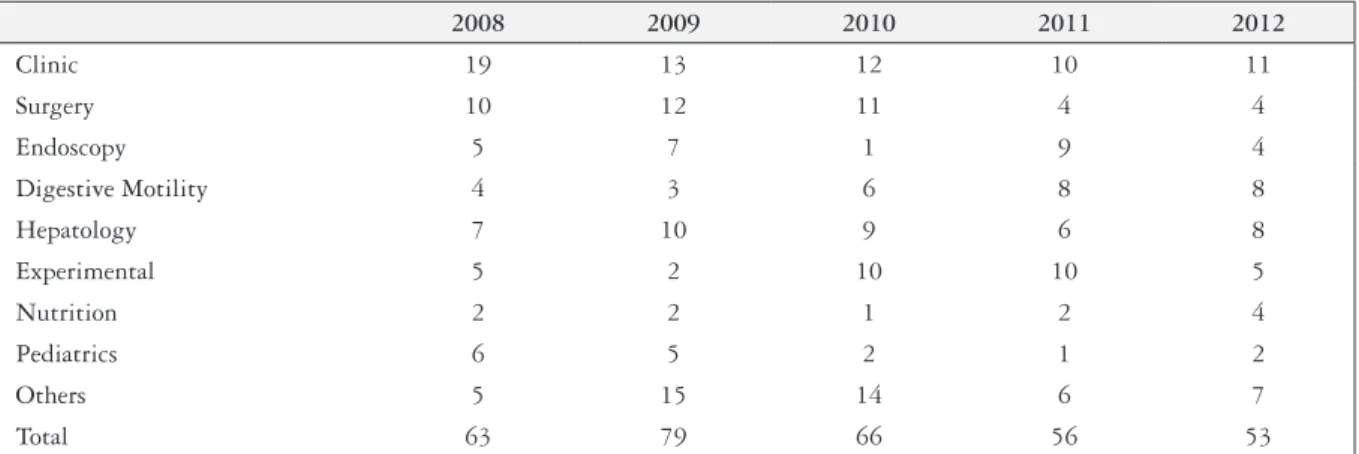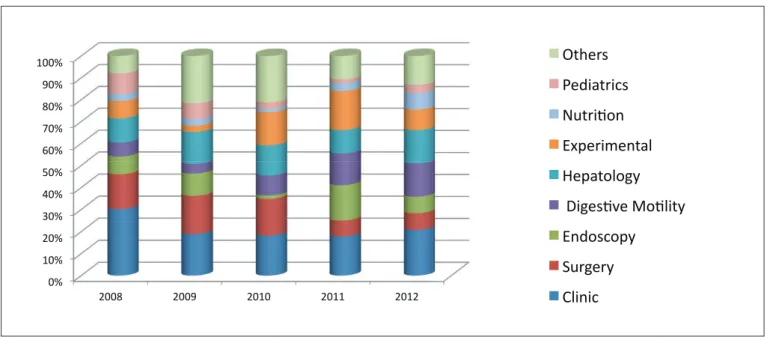ARQGA/1622
EDITORIAL
v. 49 - no. 4 - out./dez. 2012 Arq Gastroenterol 235
The contents of this issue of ARCHIVES of GASTROENTEROLOGY, composed of diverse topics related to our speciality, leads a valuable re-lection of the editorial board, always interested and concerned for the excellence of its scientiic proile, primarily in the published themes plurality’s, diver-siication areas and sub specialties that are from and the impact which aspects relects in editorial work and in the readers.
More complexly, the analysis of this editorial structure, undoubtedly recognized by our readership, has been submitted through the QUALIS criteria from CAPES, as well as the criteria of international agencies and entities that also punctuate and rank, with rigid parameters all indexed journals.
Due to this “oversight” recommended models for valuing qualitative classiication, the editors of the ARCHIVES have strived towards, insistently in improving the quality of their publications, not only in its graphic format, but also in scientiic richness.
The ARCHIVES are close to spread the Impact Factor pleaded for nearly 3 years with the JCR (Jour-nal Citation Report).
All professionals interested in the progress and quality of the ARCHIVES, have longed for this value, since it enters not only in the importance of his publications on the context of the publishing world, as well as serves as a parameter within the system QUALIS, for post-graduation entities best score. The high the impact factor leads to a post
ANOTHER SIDE OF THE EDITORIAL WALL
Viebig RG, Pardini F. Another side of the editorial wall. Arq Gastroenterol. 2011;49(4):235-6. HEADING – Scientiic and technical publications.
graduate highest score whose works were published by the ARCHIVES.
The information we have so far by other quali-ty indicators (SciELO, SCOPUS and SCImago) is that in the context the ARCHIVES occupy the 14th position among the Brazilian medical journals and the 55th in the global context of the publications in Gastroenterology.
For its peculiarity of not being tied to any univer-sity structure or specialty society in particular, on the contrary, being the oficial release of several of these societies of gastroenterology, the ARCHIVES offer various quality differentials relative to similar publi-cations: print circulation has large expression (7500 copies), provides free distribution of this release, as well as the electronic version is full free through the SciELO system, has electronic submission and peer review system.
After the implementation of the new criteria from CAPES, a decreased volume of submissions was no-ticed, since many of those graduate staff has sought greater impact by vehicles in return for receiving higher scores. This fact did not affect signiicantly the set of submissions, since the number of articles received has been suficient to ensure the quality and volume of original articles published.
The statistical lows studies reviewed, approved, denied or no return after suggestions of possible ixes to authors from 2008, is provided in Figure 1, reali-zing that even with a lower volume of submissions in
2008 2009 2010 2011 2012
Clinic 19 13 12 10 11
Surgery 10 12 11 4 4
Endoscopy 5 7 1 9 4
Digestive Motility 4 3 6 8 8
Hepatology 7 10 9 6 8
Experimental 5 2 10 10 5
Nutrition 2 2 1 2 4
Pediatrics 6 5 2 1 2
Others 5 15 14 6 7
Total 63 79 66 56 53
236 Arq Gastroenterol v. 49 - no. 4 - out./dez. 2012 Viebig RG, Pardini F. Another side of the editorial wall
1 Executive Editor. 2 Assistant Editor.
recent years, there is even a small proportional increase in immediate refusal.
Makes us feel good about the fact that once required a review of their work, most authors have treated us helpfully, returning the submissions to publishers with the corrections suggested and/or required.
In Figure 2 are exposed the quantity of articles distributed over speciic areas of Gastroenterology in the last 5 years. Although there are minor changes in the annual distribution between areas, we continue to be prestigious by researchers of all, tending to have equal distribution among them.
The statistics for the years 2011 and 2012, not yet
inali-zed, reafirms plurality, diversity and intensity of scientiic researchers and our commitment in honors them. Finally, it stand out from the foreign authors growing demand for our periodic, which although small in volume, and generally coming from emerging countries such as India, Egypt, Turkey and Portugal conirms the importance and impact that our editorial and scientiic exercise really stan-ds worldwide, reason why this assessment of the editorial body is necessary.
Ricardo Guilherme VIEBIG1 Fernando PARDINI2
ano 2008 2009 2010 2011 2012*
submissions 103 82 71 75 66
aproved 70 60 40 48 25
refused 22 17 23 27 21
waiting answer 11 5 8 0 7
* november Graphic 1
Last 5 years works flow
Figure 1
Last 5 years publications by area
Publicação por assunto
2008 2009 2010 2011 2012
Clinic 19 13 12 10 11
Surgery 10 12 11 4 4
Endoscopy 5 7 1 9 4
Digestive Motility 4 3 6 8 8
Hepatology 7 10 9 6 8
0% 10% 20% 30% 40% 50% 60% 70% 80% 90% 100%
2008 2009 2010 2011 2012
Others Pediatrics
Nutri�on Experimental Hepatology
Diges�ve Mo�lity Endoscopy Surgery Clinic
FIGURE 2. Last 5 years publications by area
ano
2008
2009
2010
2011
2012*
submissions
103
82
71
75
66
aproved
70
60
40
48
25
refused
22
17
23
27
21
waiting answer
11
5
8
0
7
* november
Graphic 1
Last 5 years works flow
Figure 1
Last 5 years publications by area
Publicação por assunto
2008
2009
2010
2011
2012
Clinic
19
13
12
10
11
Surgery
10
12
11
4
4
Endoscopy
5
7
1
9
4
Digestive Motility
4
3
6
8
8
Hepatology
7
10
9
6
8
0% 10% 20% 30% 40% 50% 60% 70% 80% 90% 100%
2008 2009 2010 2011 2012

